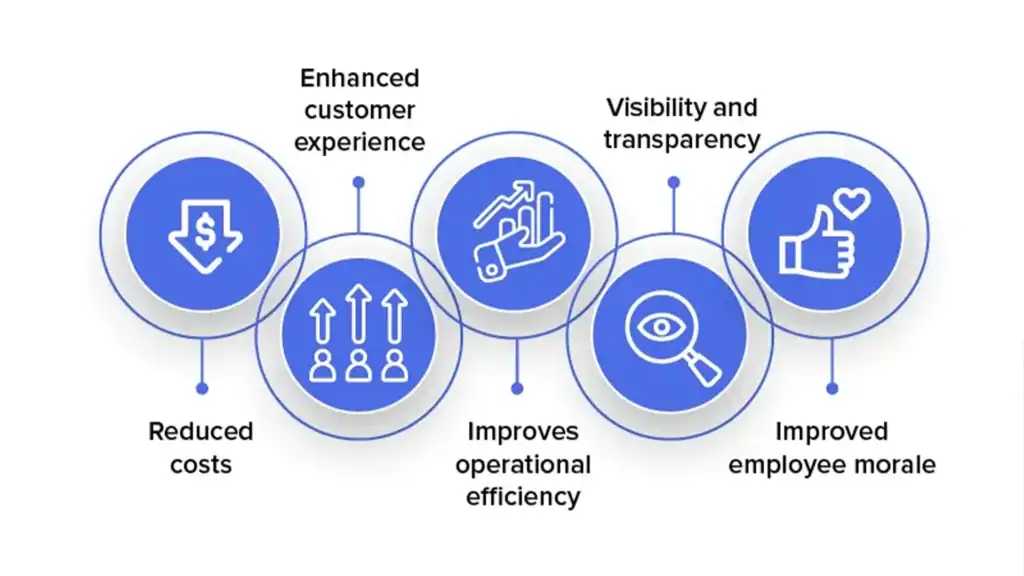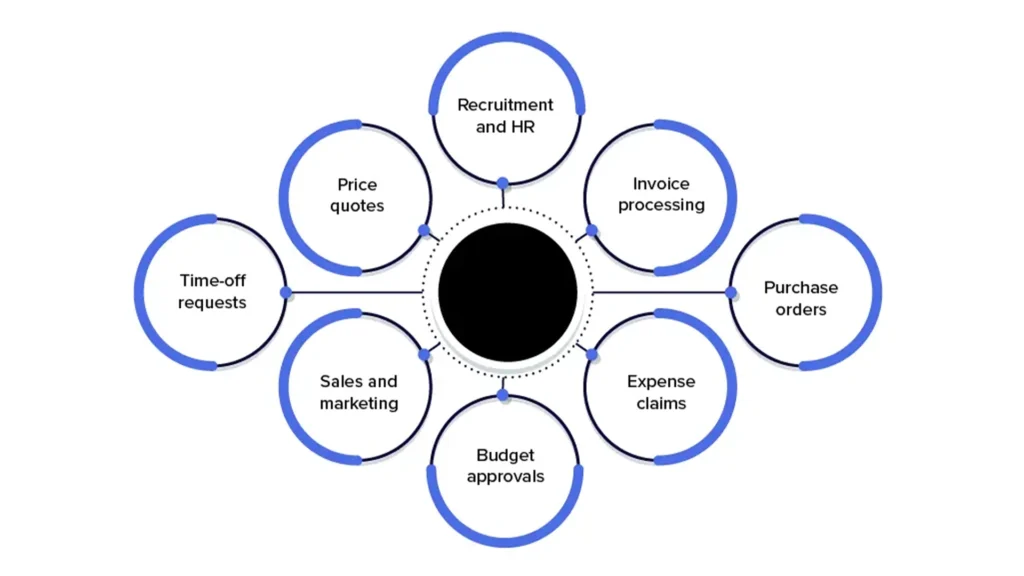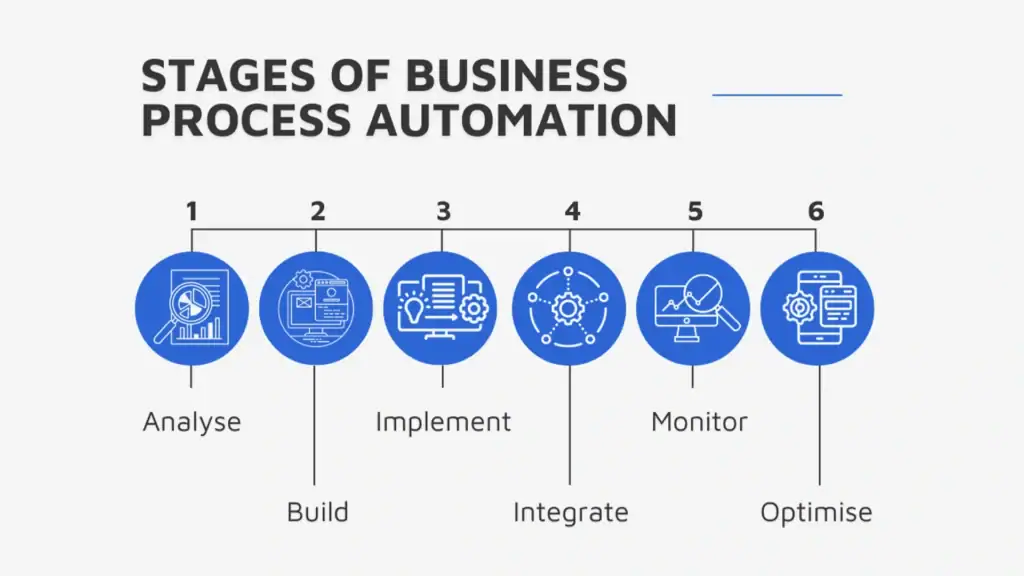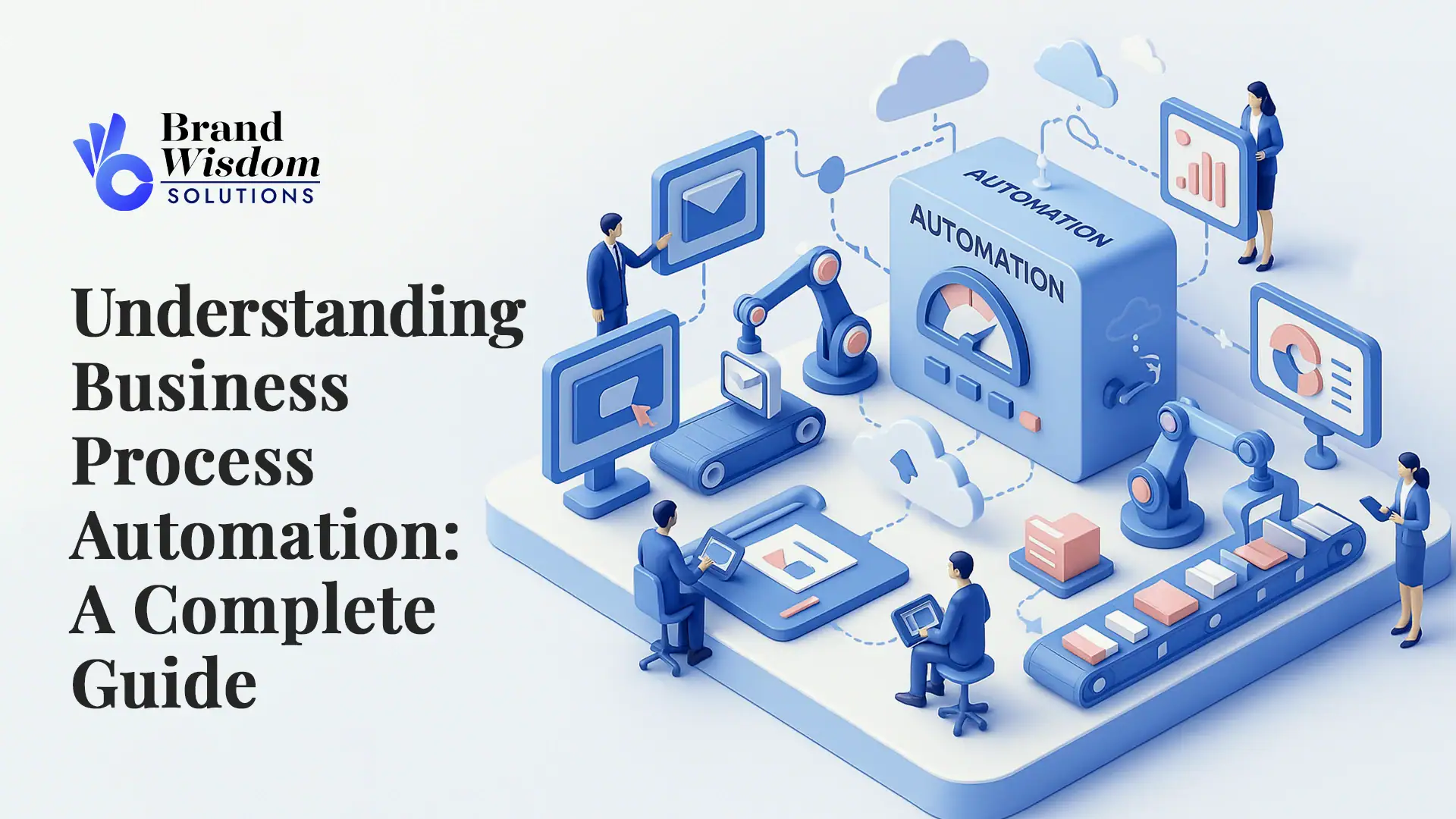In today’s busy world, process automation and workflow automation have a big impact on how businesses run. By using automation technologies, business process automation helps remove problems and makes process management better. This lets firms meet their goals faster. It focuses on cutting down manual tasks and making workflows work smoothly. This way, teams keep up steady work and get accurate results. Ready-made tools let a business handle its daily problems more easily. This guide shows how to use business process automation and help your company do better.
Let’s look at what business process automation means for a business.
What is business process automation, and how does it work?

Business process automation (BPA) involves using technology to streamline and automate repetitive tasks, improving efficiency and accuracy. It works by identifying workflows that can be automated, implementing software solutions, and monitoring processes to ensure effectiveness. Ultimately, BPA reduces manual effort, saving time and resources while enhancing productivity.
Defining Business Process Automation (BPA)

Business process automation means using technology to make business tasks easier and faster. It helps to cut down manual work, especially for repetitive tasks that take time. When you add automation software to business operations, you can boost efficiency and reduce human error. This also helps to raise productivity across the company.
Process automation covers tools and platforms that help with data entry, digital process automation, process management, and customer service. This makes it possible for business leaders to focus more on big-picture plans and less on small, daily jobs. In the long run, digital transformation through business process automation leads to better compliance and higher customer satisfaction.
Key Concepts and Terminology in BPA
BPA is all about making repetitive tasks easier by using technology. With process automation, your workflow flows in a clear, simple way. This makes sure every task follows the right process steps without mistakes. You will not face bottlenecks, and this saves time while keeping things the same every time.
BPA software is important because it helps automate things you do every day, like data entry or handling applications. This software meets your business needs and also helps different teams, like marketing or finance, to work together better.
Robotic process automation, or RPA, is part of BPA and interacts with software applications. It quickly does manual processes like filling out spreadsheets or moving data between applications. With RPA, you take less time and make fewer mistakes. All these things together are the backbone of BPA, which gives a strong and simple way for businesses to run.
Now, let’s talk about how these ideas have changed over time.
Evolution of Business Process Automation
The path of business automation has changed a lot with new technology. At first, it had only simple tools, but it slowly grew with digital transformation. This led to new and better automation technologies using cloud computing.
In the beginning, the first tries were about using machines for simple jobs like sending email alerts. Over time, better business automation tools were made. Now, these tools help the whole team or even all departments do their work faster. They help make our work grow and reach more people.
Today, business process automation software makes use of things like machine learning (ML), artificial intelligence (AI), and natural language processing. These smart tools not only help run tasks with less work from us, but they can also find trends and give insights. This means teams can do more with less, day to day. BPA is now important for any group that wants higher customer satisfaction and wants to grow without problems.
Let’s look more at what BPA can do for your company.
Core Benefits of Adopting BPA

One clear benefit of using automation tools is that they help boost operational efficiency. When companies stop using so many manual processes, the people working there get more time to focus on ideas and new ways to do things.
BPA also helps cut down on human error. This is important, especially for tasks that deal with data—like billing and customer service. As a result, things work smoothly and follow rules more easily. Also, using digital systems means you can check things on a mobile device in real-time for better tracking and higher work quality.
From now on, operational efficiency will be more important than ever.
Enhancing Operational Efficiency
Boosting operational efficiency is one of the best things about BPA. In many old ways of working, people had to handle each step, which slowed things down. With BPA, you can now use process automation to make things quicker by cutting out these slow steps. For example, BPA software helps with things like inventory control. This keeps the system running without long delays caused by problems.
Tasks such as data processing and paperwork now move smoothly between people or teams. There is less manual work because the process steps happen in order without anyone having to do each one by hand. Software dashboards help everyone see what is going on, making it easy for all departments to stay on track.
By using process automation, BPA lets teams divide up work in a smart way. Businesses can meet deadlines better. It also helps make the way you work faster and ready to handle more jobs as you grow. All these things show how important BPA is for any company that wants to do well today.
Now, let’s look at how BPA software can help cut mistakes and save money.
Reducing Errors and Costs
People can make mistakes when they do the same tasks again and again. These mistakes often lead to losses that do not have to happen. BPA helps with this problem by using automation systems to do things like payroll and data entry. With these systems, information stays right, so there are fewer mistakes in money reports or bills.
On top of that, using automation software helps with labor costs. The hard or boring jobs can be done by these programs, so people can work on better things. Companies do not just save money when they use automation for repetitive tasks. They also see things like service getting done faster.
These tools help companies plan their resources better. They also work in many different kinds of workplaces. In the long run, BPA makes work easier, helps save money, and can keep giving back to the business.
But even with all these good things, there are still some problems when setting everything up.
Common Challenges in BPA Implementation

While BPA tools can change the way you handle your business process, bringing them in can be hard. Sometimes, business process management meets problems because there is not enough paperwork, and some workflows are not clear.
When new employees or leaders join, or when there are gaps in communication, process management, and change might take longer than expected. It helps to plan well and make sure you fit BPA tools into what is already there. Working better together can make the setup stage go more smoothly.
It is important to talk with employees about their worries so that you can deal with any resistance when you move to new systems.
Change Management and Employee Resistance
Introducing BPA can break up old work routines. This often leads to pushback from team members who do not know the benefits of automation. Many people may worry their job could be replaced or that it will be hard to use new tools.
Good change management is to teach team members about how automation helps. Leaders should talk about how BPA lets people focus on creative jobs, while simple jobs get done by the system. Meeting often to ask for feedback can help clear up wrong ideas and boost how team members feel.
Making a place where people help each other lets the change happen more smoothly. It also helps the team accept automation.
Let’s talk about the problems that come up when older systems are used.
Integration with Existing Systems
Adding BPA to current systems needs some changes in the technology setup. Old systems often do not have the right application programming interfaces (APIs). This makes it hard to have smooth automation with BPA software.
To fix these problems, businesses use middleman automation platforms. These are made for certain tasks that help old systems and BPA tools work together. When companies connect their databases directly, they cut down on extra work but still keep their security safe.
It is important that the systems connect well with any outside BPA software. With good planning, companies avoid big problems and get the most out of their networks. Working in this way helps make integration happen in a better way.
Automation is used in a lot of areas—so what are the most common use cases?
Typical Business Processes Suitable for Automation

Some activities work really well with BPA solutions. These are often the usual tasks you find in HR, finance, and sales. Good candidates for automation are the jobs that happen a lot and need to be done quickly. They also often need close, real-time tracking.
Building more automation over time helps boost how much people can do without needing to do everything by hand. You can see this with onboarding steps or when a company needs to approve money matters. These are good candidates because they fit right in with custom automation.
Let’s take a closer look at automation made for finance.
Finance and Accounting Automation
In the world of finance, using automation software helps speed up things like managing purchase orders. Here are some ways it works:
- It sends invoices automatically for people to check.
- It keeps all rules and guidelines the same across records.
- It notes what happens with suppliers in real time without waiting.
- It makes records for tax and any required payout right away.
These changes help make accounts safer and steadier. Automation lets people get approvals for transactions faster, which is important in banks today. All this helps different work teams handle money tasks together in a stronger way.
Human Resources and Onboarding Processes
HR functions get a lot better when you use BPA solutions in onboarding processes within the HR department. Automating things such as gathering employee credentials brings more order and accuracy.
HR systems quickly handle entry forms. These forms include important things like direct deposit setup, device login details, and access card assignments. Fixes in the back office let recruitment teams avoid mistakes that usually take a lot of time. Now they can make the onboarding process simple and smooth.
Automated training template updates make things clearer for everyone. Statements that help guide payroll checks and fix mistakes are now part of the standard process. This cuts down errors and saves time during the onboarding steps, leading to fewer hold-ups and a much easier start for new people.
Steps to Automate a Business Process

The first step to finding automation opportunities is to look closely at your current workflows. When you map out all the process steps, you can see which ones are repetitive tasks and where people are needed for manual work. These are the areas that can really gain from using automation technologies and process automation.
Next, designing and testing automated workflows is important. Business leaders should work together with IT teams for this stage. They should use business process automation software and automation tools, including intelligent automation, to make sure new automated workflows match organizational goals. This will help improve both operational efficiency and customer satisfaction. With the right automation strategy, your business process can work better for everyone.
Identifying Automation Opportunities
Repetitive tasks are great to make easy with automation. Using automation tools on these jobs can help lower human error and make work run better. When you look at daily business operations like data entry or other administrative tasks, you often find a lot of chances to use automation. This can help reach goals set by the company. It helps to have IT teams and business leaders work together when picking which jobs to automate. They know which parts of the work could go better with new automation technologies.
Using process intelligence can also help spot manual processes that might need to be changed. It shines a light on where you can improve with automation tools. Taking these steps is a key way to move into digital transformation and make business operations work well for everyone.
Designing and Testing Automated Workflows
To set up good automated workflows, you need to start with a strong plan. This design should focus on how to make business process steps better. When you look at every step, you can find the ones that are best for automation. This helps to cut down on human intervention and lowers mistakes. After building this plan, you need to use automation software to test it well. Testing is important to make sure that the new system matches the needs of the organization and boosts operational efficiency. You also need to keep checking and making small changes to the user interface and how everything works. Doing so can make the system work better for people, improve customer experiences, and make them more satisfied.
Conclusion
Using business process automation helps make workflows better and cuts down on human error. It works for many business process areas. With automation technologies, you can handle repetitive tasks faster and focus more on strategic activities. This is true in both human resources and customer service. When you choose the right BPA solution, people in your company will notice better compliance. Your customers will also get better and quicker experiences. The need to use process automation is growing as businesses move forward in a digital world. Companies must use these tools if they want to reach their goals. It also helps their teams do well in the future by having better operational efficiency and allowing faster response times for all.
Frequently Asked Questions
What are some real-world examples of BPA in India?
Real-world examples of process automation in India can be seen in many industries. For example, companies use chatbots for customer support. They also use IoT devices to make the supply chain work better. Some businesses use AI-driven software to handle invoices. These ways of doing business process tasks help make work faster. They also cut down on mistakes and improve how the whole business runs.
How long does it take to implement BPA in a mid-sized business?
The time it takes to set up business process automation in a mid-sized company can be different for everyone. It may take just a few weeks, or it could take several months. The process depends on how complex the work is, what systems are already in place, and how much training employees will need for the new way of doing things. These factors can make the timeline longer or shorter when starting with process automation.
Can BPA be integrated with legacy systems?
Yes, it is possible for business process automation (BPA) to work with older legacy systems. This is important to help keep the current workflows in each business while also making them better. With good planning and using the right tools in the middle, there can be easy talking between modern BPA tools and the older systems. This type of process automation helps keep valuable data and business process steps safe. It also helps your business work better over time.
What skills are needed for successful BPA adoption?
To be successful with BPA, you need some key skills. You should know how to look at and understand processes. It helps to be good at project management. You also need to feel comfortable with using technology. You have to be able to talk to people well. You must be good with change and help others get used to new things when automation is put in place. Keep learning and be ready to change, because this field keeps moving forward.
Is BPA suitable for small businesses in India?
Yes, BPA works well for small businesses in India. It helps make daily work smoother and cuts costs. This, in turn, makes people get more done at work. When the business uses BPA to handle the repetitive tasks, it lets the team focus on growing the business and making customer experiences better. This can also help the business stay ahead of others in the market.




